|
|
|
Sort Order |
|
|
|
Items / Page
|
|
|
|
|
|
|
| Srl | Item |
| 1 |
ID:
119191
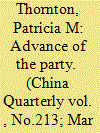

|
|
|
|
|
| Publication |
2013.
|
| Summary/Abstract |
While existing scholarship focuses attention on the impact of state control and repression on Chinese civil society, the increasingly independent role of the Communist Party has been largely overlooked. This article reviews the Party's drive to "comprehensively cover" grassroots society over the previous decade against the theoretical debate unfolding among Chinese scholars and Party theoreticians regarding the Party's role with respect to civil society. Focusing on greater Shanghai, frequently cited as a national model of Party-building, I describe the Party's advance and the emergence of Party-organized non-governmental organizations (PONGOs), a new hybrid form of social organization sponsored and supported by local Party committees. I argue that these developments invite a reconsideration of our understandings of the ongoing "associational revolution" and of the Party's relationship to China's flourishing "third realm."
|
|
|
|
|
|
|
|
|
|
|
|
|
|
|
|
| 2 |
ID:
174697
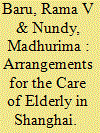

|
|
|
|
|
| Summary/Abstract |
This article looks at the arrangements for the care of elderly in Shanghai through the conceptual framework of the ‘care diamond’ and ‘continuum of care’. The findings, that are based on fieldwork conducted by the authors in Shanghai, delineate what constitutes care diamond in the city for the elderly population. This is mapped through the levels of care from home-based to tertiary-level end-of-life services that are needed by the elderly population. It also looks at the emerging markets of care in this sector and discusses whether multiple actors providing a range of services achieve continuum of care for Shanghai’s elderly population.
|
|
|
|
|
|
|
|
|
|
|
|
|
|
|
|
| 3 |
ID:
143439
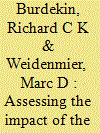

|
|
|
|
|
| Summary/Abstract |
The November 2008 Chinese stimulus package seemed to provide almost ideal preconditions for governmental success based upon its size, its concentration on infrastructure, accompanying fiscal expansion at the local level, and supportive expansions in bank lending rates. Our sectoral-level analysis suggests that investor reactions were quite tightly focused, however, with Shanghai market outperformance concentrated primarily in the nation's property, construction, and building materials sectors. Further significant post-stimulus gains accrued to the specifically targeted automobile, steel and textile industries. Meanwhile, Chinese company listings in Hong Kong and New York evinced little sectoral outperformance.
|
|
|
|
|
|
|
|
|
|
|
|
|
|
|
|
| 4 |
ID:
029496
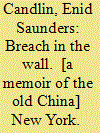

|
|
|
|
|
| Publication |
New York, Macmillan Publishing Company Inc., 1973.
|
| Description |
340p.hbk
|
|
|
|
|
|
|
|
|
|
|
|
Copies: C:1/I:0,R:0,Q:0
Circulation
| Accession# | Call# | Current Location | Status | Policy | Location |
| 015858 | 951/CAN 015858 | Main | On Shelf | General | |
|
|
|
|
| 5 |
ID:
126156


|
|
|
|
|
| Publication |
2013.
|
| Summary/Abstract |
In May 1949 the Chinese Communist Party seized Shanghai. Rather than being elated at the prospect of harnessing the economic power of China's largest city to complete the revolution, the Communists approached it cautiously. How would the Chinese Communist Party set about transforming this free-wheeling port city with a 'semi-colonial' past into an orderly and socialist city? How would it balance ideology and pragmatism in reshaping Shanghai? This paper uses the takeover of two British companies as case studies to explore these issues at the ground level. It is argued that the means by which these companies were transformed tell us much about the Party and its state-building policies. When cadres entered foreign companies, their priority was not radical change and anti-imperialism, but rather fostering a sense of stability and unity to avoid disrupting production. Their gradual approach was due in large part to the Party's awareness of its own limited skills, resources and manpower, but also to its leaders and cadres recognizing that before they could remake Shanghai anew they had first to deal with the material and human legacies of the past.
|
|
|
|
|
|
|
|
|
|
|
|
|
|
|
|
| 6 |
ID:
114058
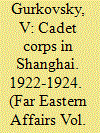

|
|
|
|
|
| Publication |
2012.
|
| Summary/Abstract |
During the Civil War in Russia and the exodus of the White Guard several cadet corps emigrated from Russia along with it. Part of them got to China (Shanghai). The author examines this aspect of the history of Russian emigration in China on the basis of memoirs and archive material.
|
|
|
|
|
|
|
|
|
|
|
|
|
|
|
|
| 7 |
ID:
023768


|
|
|
|
|
| Edition |
Abridged English ed.
|
| Publication |
New York, St. John's University, 1981.
|
| Description |
lxi, 978p.Hbk
|
| Contents |
Abridge Edition by Chun Ming Chang.
|
| Standard Number |
087075259
|
|
|
|
|
|
|
|
|
|
|
|
Copies: C:1/I:0,R:0,Q:0
Circulation
| Accession# | Call# | Current Location | Status | Policy | Location |
| 020661 | 923.159249/FUR 020661 | Main | On Shelf | General | |
|
|
|
|
| 8 |
ID:
142185
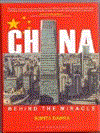

|
|
|
|
|
| Publication |
New Delhi, Bloomsbury Publishing India Pvt Ltd, 2015.
|
| Description |
239p.hbk
|
| Standard Number |
9789385436345
|
|
|
|
|
|
|
|
|
|
|
|
Copies: C:1/I:0,R:0,Q:0
Circulation
| Accession# | Call# | Current Location | Status | Policy | Location |
| 058404 | 338.951/DAW 058404 | Main | On Shelf | General | |
|
|
|
|
| 9 |
ID:
027837
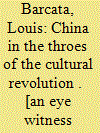

|
|
|
|
|
| Publication |
New York, Hart publishing company, 1967.
|
| Description |
299p.hbk
|
|
|
|
|
|
|
|
|
|
|
|
Copies: C:1/I:0,R:0,Q:0
Circulation
| Accession# | Call# | Current Location | Status | Policy | Location |
| 003674 | 951.056/BAR 003674 | Main | On Shelf | General | |
|
|
|
|
| 10 |
ID:
060537
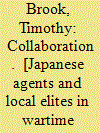

|
|
|
|
|
| Publication |
Cambridge, Harvard University Press, 2005.
|
| Description |
xi, 288p.Hbk
|
| Standard Number |
0674015630
|
|
|
|
|
|
|
|
|
|
|
|
Copies: C:1/I:0,R:0,Q:0
Circulation
| Accession# | Call# | Current Location | Status | Policy | Location |
| 049504 | 940.531630951/BRO 049504 | Main | On Shelf | General | |
|
|
|
|
| 11 |
ID:
163714
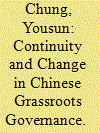

|
|
|
|
|
| Summary/Abstract |
Since the retreat of the workplace system, Chinese cities have been presented with the important challenge of refurbishing local administrative systems at the sub-district level while meeting the emerging needs of new urban spaces. Building on new institutionalism concepts such as conversion and layering, this study examines conditions in Shanghai to ascertain what has made it a strong administrative city. The study discusses the development of Shanghai’s current local governance structure in terms of historical legacy, formal structure, and informal practices (i.e., two-tiered government and three-tiered management). This study also researches the complex state task of strengthening sub-district governance (so-called “community construction”) in urban China. The results of this study offer theoretical implications for institutional change and continuity related to these matters, thereby indicating that increased attention should be given to the agency-side explanation of endogenous institutional changes in the Chinese polity.
|
|
|
|
|
|
|
|
|
|
|
|
|
|
|
|
| 12 |
ID:
141109
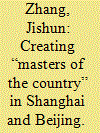

|
|
|
|
|
| Summary/Abstract |
The first round of elections for local people's congresses was an important moment in the Chinese Communist Party's efforts to create an image of the common people as the “masters of the country.” Lower-class people were portrayed in official propaganda as “masters” who were also supporters of the Party. Yet, those “masters” nevertheless displayed diverse political attitudes that were influenced by different local political cultures, particularly in Beijing and Shanghai. The official propaganda promoting the “masters” was a Communist strategy to gain political legitimacy that ironically created the foundation for heterodox mass movements.
|
|
|
|
|
|
|
|
|
|
|
|
|
|
|
|
| 13 |
ID:
144558
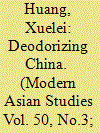

|
|
|
|
|
| Summary/Abstract |
Smell is deeply meaningful to human beings. Often considered elusive, ephemeral, and volatile, it has long been excluded from scholarly accounts on culture and history. This article explores this ‘lower’ sense and the roles it played in the historical process of modernization in China. Through a close look at the efforts made by the Western colonial administration to deodorize Shanghai as well as diverse Chinese reactions, this article argues that smell constituted a hidden site where the dynamics of power relations were played out. Smell also opened up a window to showcase modernity's power and ambivalence. The first part of this article looks at how China smelled to the Western nose, against the historical background of the rising consciousness of smell, sanitation, and civility in Europe which began in the eighteenth century. The second part examines the ways in which the British administration applied the olfactory norms of the modern West to the end of taming Chinese stench. The final part provides a case study of ordure treatment in order to show how ambivalence arose in this modern smellscape and why.
|
|
|
|
|
|
|
|
|
|
|
|
|
|
|
|
| 14 |
ID:
168174
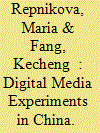

|
|
|
|
|
| Summary/Abstract |
With the rapid decline of traditional media in China, the party-state faces the growing challenge of shaping public opinion online. This article engages with one response to this challenge – a state-sanctioned digital media experiment aimed at creating a new form of journalism that appeals to the public and helps to disseminate Party propaganda. We analyse the emergence of a national success story, Shanghai-based model media outlet Pengpai, and its diffusion across different regions. We argue that the synergy between local officials and media entrepreneurs has propelled Pengpai’s national fame. We further demonstrate that while there has been a cross-national attempt to diffuse this model, it has produced mixed results owing to a number of factors, including the superficial commitment of local officials and media professionals. These findings demonstrate that state-sanctioned decentralized experimentation can deliver unpredictable results in the sphere of media policy, and they further question the capacity of the party-state to effectively reinvent public persuasion in the digital age.
|
|
|
|
|
|
|
|
|
|
|
|
|
|
|
|
| 15 |
ID:
072715
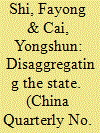

|
|
|
|
|
| Publication |
2006.
|
| Summary/Abstract |
Collective action directed at the government is not rare in China, but why some actions endure and succeed whereas many others fail remains inadequately addressed. Based on a case of home owners' sustained collective resistance in Shanghai, this study finds that state power is fragmented at the local level. While the disparate priorities among different levels of state authorities provide opportunities for resistance, social networks between participants of collective action and officials or media workers may significantly help the former to achieve success.
|
|
|
|
|
|
|
|
|
|
|
|
|
|
|
|
| 16 |
ID:
117792


|
|
|
| 17 |
ID:
098210
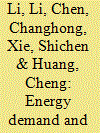

|
|
|
|
|
| Publication |
2010.
|
| Summary/Abstract |
In this paper, Shanghai's CO2 emissions from 1995 to 2006 were estimated following the IPCC guidelines. The energy demand and CO2 emissions were also projected until 2020, and the CO2 mitigation potential of the planned government policies and measures that are not yet implemented but will be enacted or adopted by the end of 2020 in Shanghai were estimated. The results show that Shanghai's total CO2 emissions in 2006 were 184 million tons of CO2. During 1995-2006, the annual growth rate of CO2 emissions in Shanghai was 6.22%. Under a business-as-usual (BAU) scenario, total energy demand in Shanghai will rise to 300 million tons of coal equivalent in 2020, which is 3.91 times that of 2005. Total CO2 emissions in 2010 and 2020 will reach 290 and 630 million tons, respectively, under the BAU scenario. Under a basic-policy (BP) scenario, total energy demand in Shanghai will be 160 million tons of coal equivalent in 2020, which is 2.06 times that of 2005. Total CO2 emissions in 2010 and 2020 in Shanghai will be 210 and 330 million tons, respectively, 28% and 48% lower than those of the business-as-usual scenario. The results show that the currently planned energy conservation policies for the future, represented by the basic-policy scenario, have a large CO2 mitigation potential for Shanghai.
|
|
|
|
|
|
|
|
|
|
|
|
|
|
|
|
| 18 |
ID:
098540
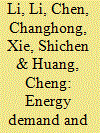

|
|
|
|
|
| Publication |
2010.
|
| Summary/Abstract |
In this paper, Shanghai's CO2 emissions from 1995 to 2006 were estimated following the IPCC guidelines. The energy demand and CO2 emissions were also projected until 2020, and the CO2 mitigation potential of the planned government policies and measures that are not yet implemented but will be enacted or adopted by the end of 2020 in Shanghai were estimated. The results show that Shanghai's total CO2 emissions in 2006 were 184 million tons of CO2. During 1995-2006, the annual growth rate of CO2 emissions in Shanghai was 6.22%. Under a business-as-usual (BAU) scenario, total energy demand in Shanghai will rise to 300 million tons of coal equivalent in 2020, which is 3.91 times that of 2005. Total CO2 emissions in 2010 and 2020 will reach 290 and 630 million tons, respectively, under the BAU scenario. Under a basic-policy (BP) scenario, total energy demand in Shanghai will be 160 million tons of coal equivalent in 2020, which is 2.06 times that of 2005. Total CO2 emissions in 2010 and 2020 in Shanghai will be 210 and 330 million tons, respectively, 28% and 48% lower than those of the business-as-usual scenario. The results show that the currently planned energy conservation policies for the future, represented by the basic-policy scenario, have a large CO2 mitigation potential for Shanghai.
|
|
|
|
|
|
|
|
|
|
|
|
|
|
|
|
| 19 |
ID:
187015
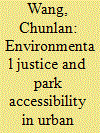

|
|
|
|
|
| Summary/Abstract |
This article applies the pluralistic concept of environmental justice to the issue of park accessibility between people across different socioeconomic strata in the metropolitan region of Shanghai. Data were obtained from China's 2000 and 2010 population census, Shanghai Landscaping and City Appearance Administrative Bureau, semi-structured interviews and secondary sources. The article finds significant environmental injustice between foreign citizens and Chinese citizens (including people from Hong Kong, Macau and Taiwan and mainland people with and without Shanghai hukou) and between blue collar, white collar and wealthy white collar people from distributive, recognition, participatory and procedural justice perspectives. The article then discusses why such injustice is the result of urban China's unique authoritarian mode of governance, power structure, neoliberal practice and globalisation development. The findings offer insights into the development of the concept of environmental justice in the Chinese context and the country's objective to build an impartial society.
|
|
|
|
|
|
|
|
|
|
|
|
|
|
|
|
| 20 |
ID:
079961
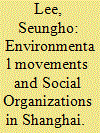

|
|
|
|
|
| Publication |
2007.
|
| Summary/Abstract |
This research aims to analyze environmental movements and social organizations in Shanghai since the late 1990s. The study reveals that civil society in Shanghai has increasingly had an impact on environmentally unfriendly policies given the priority of economic well-being in every aspect of society. The development of social organizations in environmental protection in Shanghai was identified through fieldwork carried out in 2002. Alongside existing social organizations already engaged in environmental protection, there was also an emergence of new social organizations. Most of the environmental NGOs in Shanghai-spearheaded by university students-lack capacity to exert much influence on environmental policies. In addition to student-based environmental NGOs, other types of social organizations include government-organized NGOs (GONGOs), local communities (shequ), the media, and international NGOs. The study evaluates how the local environmental NGOs in Shanghai evolved and survived in the transitional period interacting with other social organizations. It is concluded that a collaboration of GONGOs, NGOs, and various environmental groups together with international NGOs has led to the formation of a civil force that influences Shanghai's environmental policymaking
|
|
|
|
|
|
|
|
|
|
|
|
|
|
|
|
|
|
|
|
|